How we launched the space telescope
On Thursday, December 19, 2013, the Gaia Space Telescope of the European Space Agency traveled to space on a Russian Soyuz-ST-B rocket with a Fregat-MT booster. The launch was made from the Kourou space center in French Guiana.
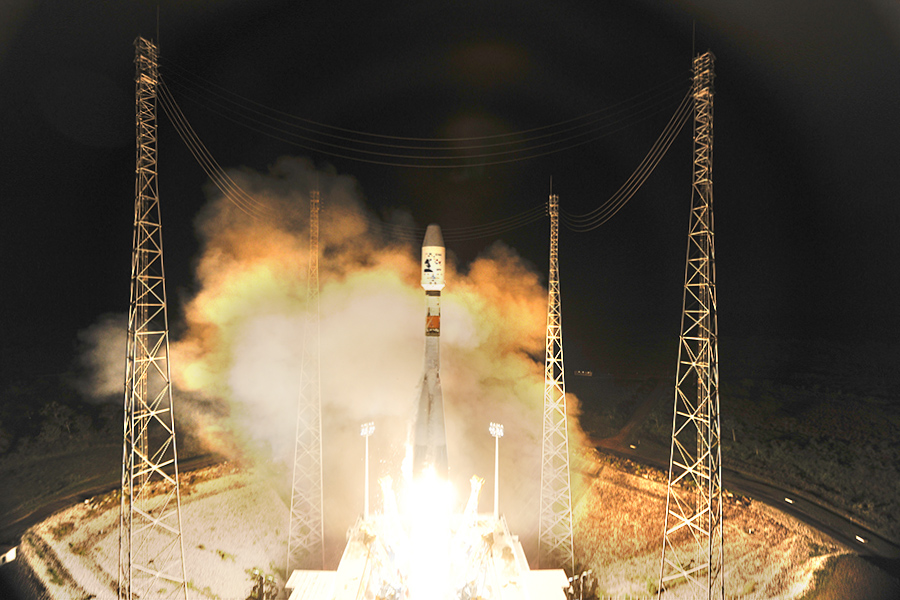
The launch was successful, and as he was passing I was able to observe from the Mission Control Center of the NPO. S.A. Lavochkin, where they invited several bloggers. NPOL is a manufacturer of the Fregat upper stage, therefore it controls its operation during spacecraft launch. In fact, teams from the Moscow Region MCC are not given to the Frigate, but only information is being received and analyzed. Therefore, in this mission, the work function of the PMU-L is the provision of information services to the Arianespace company, which launches the rocket. Those. outsiders, like all bloggers, would not have prevented the successful removal of the rocket and the telescope. Unfortunately, I did not know such subtleties, so I left a large SLR camera at home so as not to distract the Centre’s employees. I took a digital camera with a superzoom, which affected the quality of images, for which I apologize to readers.
')
The launch command was carried out by the French in Guyana, and after the apparatus was separated from the upper stage, control was transferred to the ESA MCC in Darmstadt.
MCC-L is not very similar to those of which manned launches or ISS are controlled. It is smaller and there is only one row of tables with computers. But the huge screen in the entire wall is present as it should be.
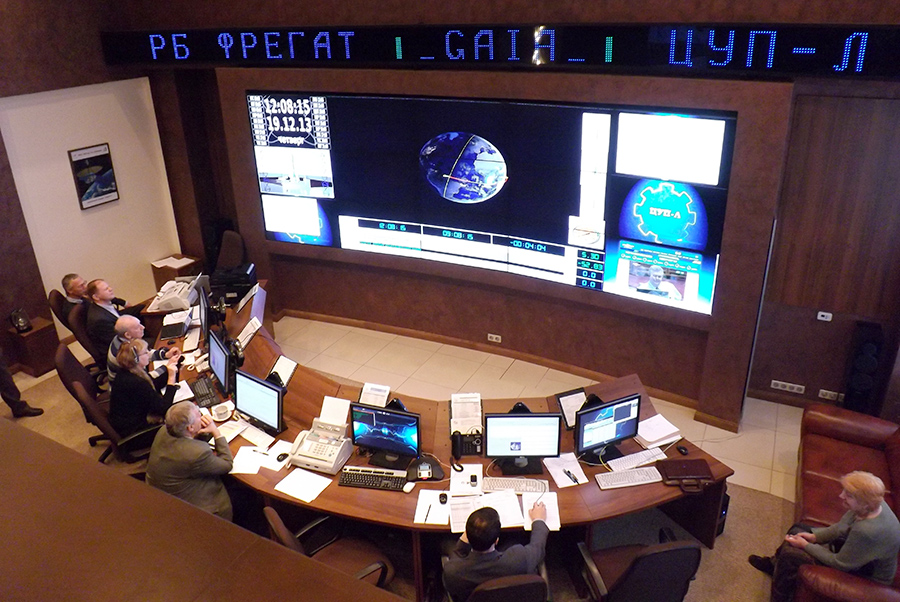
More precisely, there are two of them here. The second one contains information on the already existing devices of NPOL: " Electro-L " and " Spectr-R ":

Pay attention to the distance from the Earth, in the lower right corner. Almost flew to the moon. The orientation of the apparatus at the Earth and the Sun corresponds to the position in orbit in real time, and is determined by the transmitted telemetry.
In MCC-L, we arrived an hour and a half before the start. We were placed on the balcony, where you can watch the events and not distract from the work of those who are at the bottom. The loudspeakers transmitted commands that were given at the spaceport. The rocket was placed a few days later, so before the launch it was only necessary to carry out the final preparatory procedures, and disperse everyone far away from the danger zone.
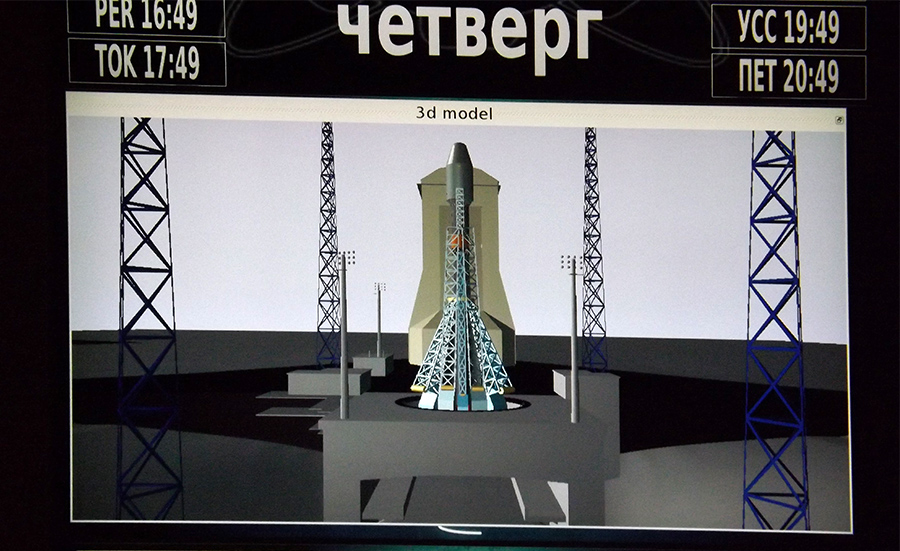
The space on the balcony was filled. Representatives of the leadership mainly approached; Yury Kazakevich, Head of MCC-L, was invited, at the invitation of which we were there; was the chief designer of the "Frigate" Vladimir Asyushkin. The general director of the company, Viktor Hartov, was at that time at the launch site in Guyana.
For NPOL this launch is special - this is the fortieth “Frigate”. Almost all of his flights were successful, with the exception of the partially successful launch of the Meridian-2 satellite, which was put into unplanned orbit in 2009, but there the fault lies on the third stage of the rocket, and the Frigate, on the contrary, pulled the device somewhere, not letting fall. Only Phobos-Grunt can be considered a failure, it was created on the basis of the Frigate, but the control system was completely replaced there, and a number of design changes were made, so formally it was no longer Fregat. In general, today it is one of the most reliable overclocking blocks in Russia, which explains why the Europeans use it.
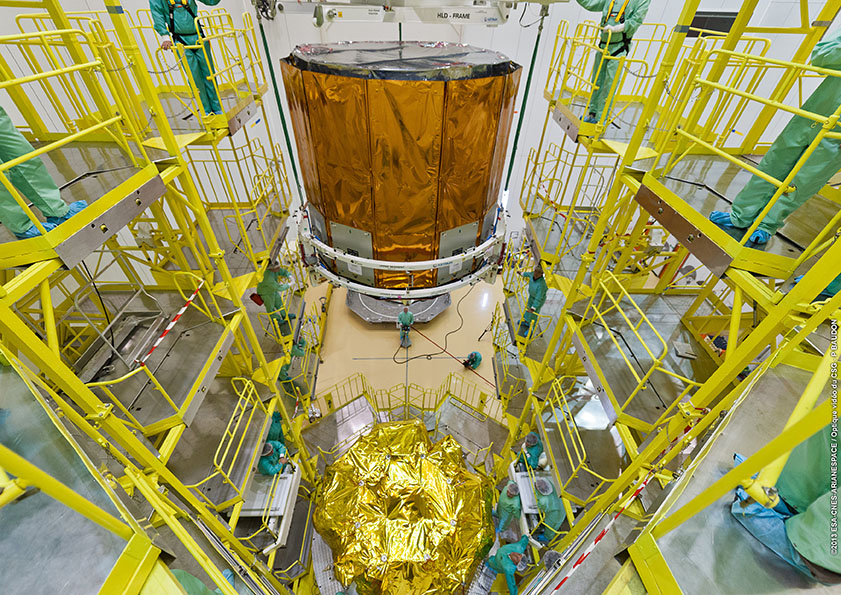
In the meantime, “Minute Readiness” was commanded on the launch pad. I already knew that this does not mean starting in a minute. There were still a few minutes before the launch, but the tension was increasing. Visitors to the TsUP balcony, who had previously spoken or read a cyclogram and ballistic data, got up and stared at the monitors.
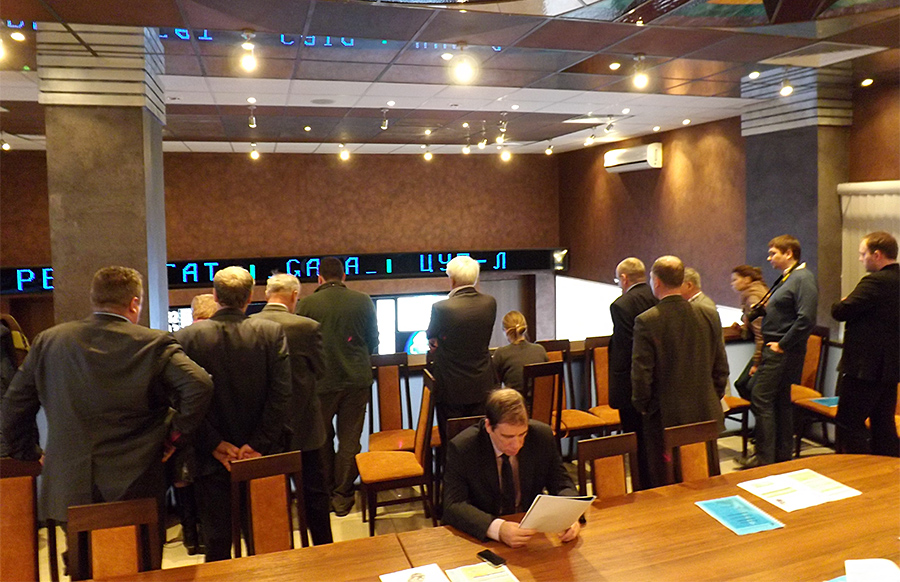
There, the technicians tried to adjust the live broadcast from the spaceport. There was no suitable satellite transponder, so they gave a picture from the site Arianespace . It is curious that she came with a 60-second delay, i.e. we received information a minute earlier than the rest of the world.
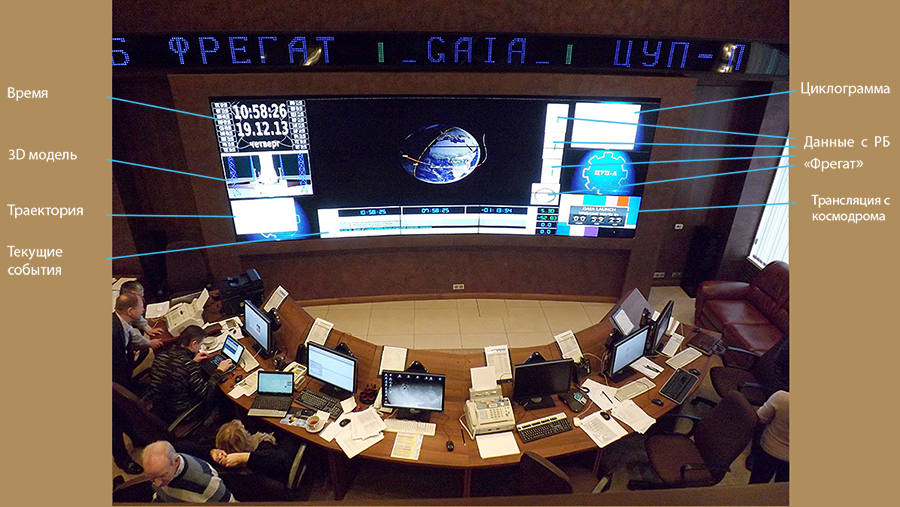
The French representatives were located at the bottom left. There you can also consider fax. Although this device seems today an anachronism, but it is this method of transmitting information adopted in Arianespace. However, Roskosmos, by fax, also works more readily than by e-mail.
A model of the Earth was displayed on the central monitor, with a marked flight path of the rocket and upper stage. The active sites on which the rocket engines operate are marked in red, the passive ones in white. The yellow ring is the terminator line, i.e. border day and night. The following stations are marked in yellow on the surface: Galliot, Natal, Asansion (Ascension Island), Libreville, Mauritius, Perth, which receive information from the spacecraft:

Remember the Soviet scientific ships with giant plates?

For this purpose, they were needed - to control the flight of our vehicles where there is no possibility to "lead" them from the Earth. Now Russia has no such ships, therefore our vehicles fly in a blind zone for a significant part of the way. Only in conditions of force majeure, foreigners can provide us with the help of their stations. For example, "Phobos-Grunt" caught the whole world ...
The cherished commands “The key to the start ”, “ Pulling ”, “ Blowing out ” sounded ... “There is a lift contact”:
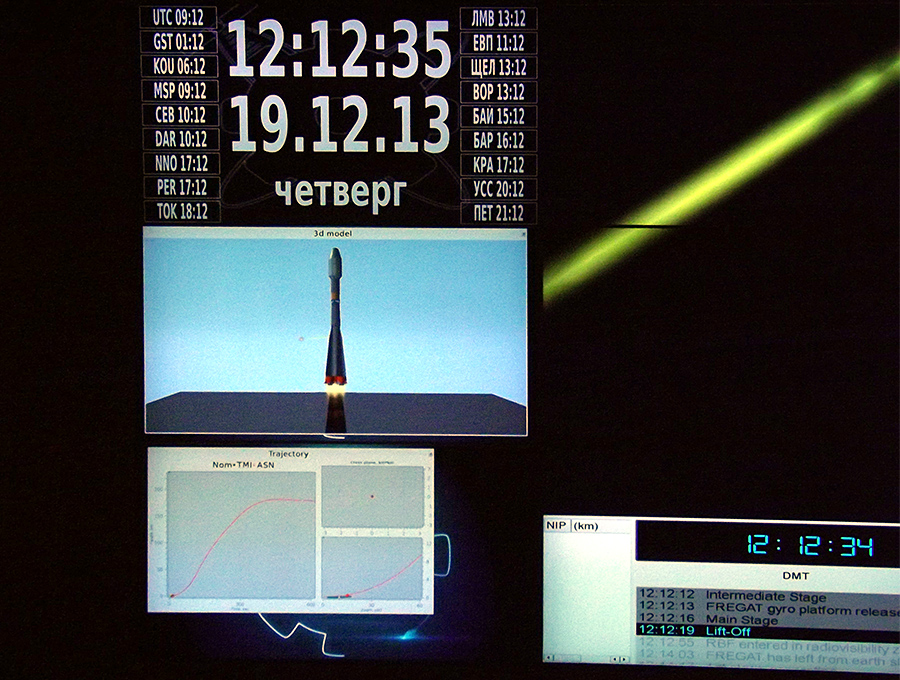
Everyone froze peering at the numbers on the monitors. These were our “nine minutes of fear.” Soyuz is a reliable rocket, but no one is immune from error, so the voltage has reached the limit.
While the rocket was flying, the Samara team gave commands, and in the dry reports “ Control system parameters are normal ”, “ Design parameters are normal ”, “ Second stage engine is working normally ”, “ Product stabilization is stable ”, genuine pride was heard and, it seemed to me some kind of aggression. As if the speaker was throwing these phrases to all skeptics who were in a hurry to write about the ocean satellite constellation when they heard that Gaia is being displayed by the “Union”.

Finally, the long-awaited report for Samara sounded: “ There is a third stage engine shutdown. There is a head unit compartment. The Fregat-MT accelerating unit with Gaia spacecraft is put into open orbit. The report is over .”

The short life of the Frigate began.
An unclosed orbit means that without an additional accelerating pulse, the spacecraft would again enter the dense layers of the atmosphere and burn out. The booster unit needs to bring the speed to the first spacecraft and continue working in order to send the telescope to the departure trajectory. The first activation of the marching propulsion system is necessary for a set of the first cosmic velocity, and an exit into the reference orbit. After that, over the Atlantic, passive part of the flight, and then the engine was turned on again.
As we were told: 15-minute continuous operation of the engine is a record for the Frigate. Previously, he treated with shorter pulses. On tests, the engine showed the possibility of half-hour work. He also allows repeated inclusions. Again, tests have proven its ability to carry out up to 40 inclusions, although in practice the engine did not start more than six times. Sometimes several satellites in one flight are required to be diluted into different orbits.

The second launch of the engine during Gaia removal was necessary to climb and send the telescope to an elliptical orbit. Before the ascent, the spacecraft, on the contrary, slightly decreased, and only then rushed up:

The trajectory table shows three values: the red and white line is the way the ship should fly according to the program; green - how it flies according to onboard orientation devices; yellow - according to external surveillance systems.
"Gorka" started over Africa. The diagram has become noticeable as the frigate's radio visibility limits increase as the height increases. I hoped that it would rise high enough over the Indian Ocean to become noticeable for Electro-L, but it rose just above 1,500 km, which is clearly not enough for a meteorological satellite camera in geostationary orbit.

A few minutes after the second shutdown of the Fregat engine, the most important event for NPO Lavochkin was held that day’s event. The loudspeaker announced the following messages: " A command was issued to separate the Gaia spacecraft from the Fregat upper stage , and then:" Attention. According to the telemetric information, there is a spacecraft branch ":
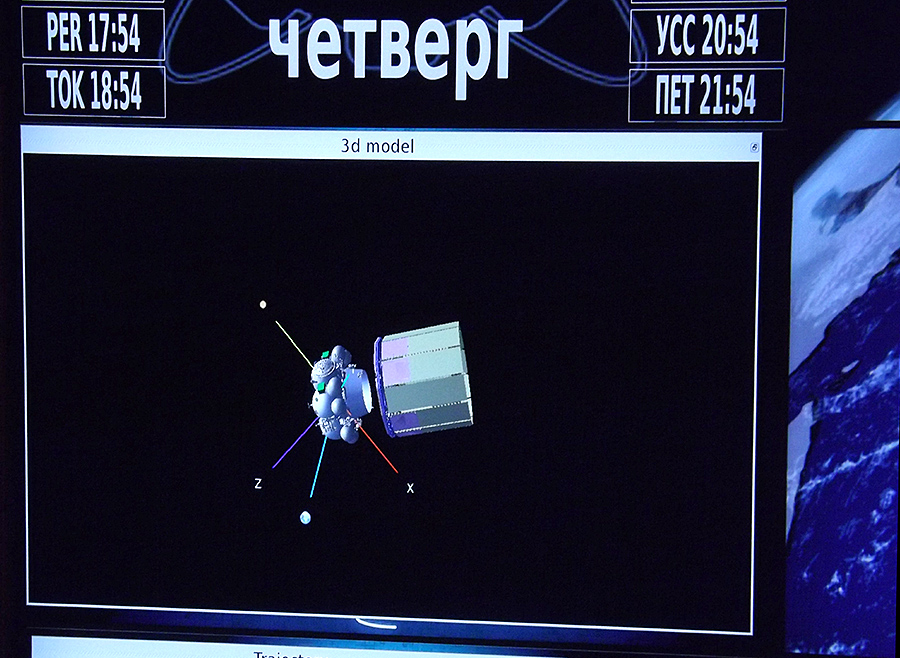
Applause rang out, the tension dissipated, and everyone rushed to shake hands and congratulate. Russia has made its contribution to the future success of the Gaia Galaxy Space Telescope and Cartographer. It was launched into an elliptical orbit with a maximum altitude of 952 thousand km and a minimum of 350 km. But at least the telescope should not return. It needs to turn on its own engines in order to gain a second cosmic velocity, and to “break” the ellipse in order to permanently leave the near-Earth orbit. The process of acceleration and correction to take the departure trajectory should take 96 hours or 4 days, i.e. at the moment it is not yet complete. The path to the goal - the L2 point of the Earth-Sun system, at a distance of 1.5 million km, will take several weeks.
But for the "Frigate" work is not over. He had to be led away from the spacecraft to eliminate the danger of a collision. Usually, the accelerating units try to sink in order not to leave space debris in orbit. However, in this case it became impossible because of the high speed, high altitude of the spacecraft, and insufficient fuel supplies. The only thing that could be done here was to put the Frigate aside.

The third short start of the engine sent a booster into orbit, in fact, of eternal storage. Now it will revolve around the Earth, flying away at 2.16 million km and returning every 130 days to rush above us at an altitude of 381 km. The only thing that can be done to prevent unnecessary littering of space is to passivate: openings are opened in the fuel tanks, through which fuel residues are etched. Now it, at least, will not blow up from heating by sunshine. Previously, this happened with the acceleration units and the third stages of rockets.
After the “Frigate” set off on its last journey, we were escorted to the floor above and showed the “brain” of MCC-L - the analytical department. This is the place where the main work is carried out to provide information to the Mission Control Center - here telemetry information is obtained and analyzed. This department struck by the difference in the age of employees. However, such a picture rather shows a general state with personnel in the industry. There I managed to take a photo, which I would call: “Russian space today: gray hair and geeks”:
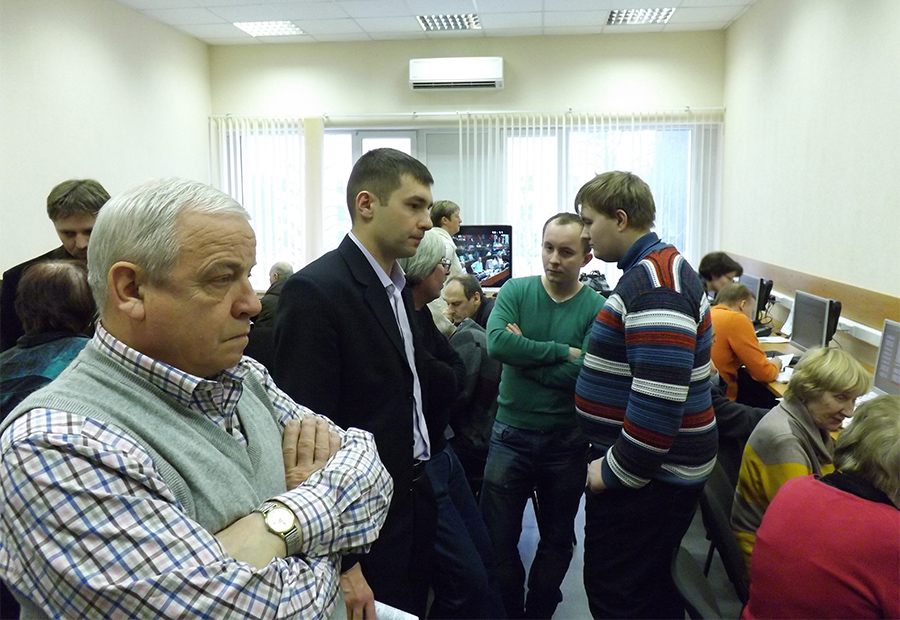

Hopefully, these guys and girls will make their leap into space, like those who are sharing their experiences with them. We can only morally support them in this endeavor.
Still need to thank the leadership of the NGO. S.A. Lavochkin, because they are taking the first steps in order to make the Russian space more open to the public.

The launch was successful, and as he was passing I was able to observe from the Mission Control Center of the NPO. S.A. Lavochkin, where they invited several bloggers. NPOL is a manufacturer of the Fregat upper stage, therefore it controls its operation during spacecraft launch. In fact, teams from the Moscow Region MCC are not given to the Frigate, but only information is being received and analyzed. Therefore, in this mission, the work function of the PMU-L is the provision of information services to the Arianespace company, which launches the rocket. Those. outsiders, like all bloggers, would not have prevented the successful removal of the rocket and the telescope. Unfortunately, I did not know such subtleties, so I left a large SLR camera at home so as not to distract the Centre’s employees. I took a digital camera with a superzoom, which affected the quality of images, for which I apologize to readers.
')
The launch command was carried out by the French in Guyana, and after the apparatus was separated from the upper stage, control was transferred to the ESA MCC in Darmstadt.
MCC-L is not very similar to those of which manned launches or ISS are controlled. It is smaller and there is only one row of tables with computers. But the huge screen in the entire wall is present as it should be.

More precisely, there are two of them here. The second one contains information on the already existing devices of NPOL: " Electro-L " and " Spectr-R ":

Pay attention to the distance from the Earth, in the lower right corner. Almost flew to the moon. The orientation of the apparatus at the Earth and the Sun corresponds to the position in orbit in real time, and is determined by the transmitted telemetry.
In MCC-L, we arrived an hour and a half before the start. We were placed on the balcony, where you can watch the events and not distract from the work of those who are at the bottom. The loudspeakers transmitted commands that were given at the spaceport. The rocket was placed a few days later, so before the launch it was only necessary to carry out the final preparatory procedures, and disperse everyone far away from the danger zone.

The space on the balcony was filled. Representatives of the leadership mainly approached; Yury Kazakevich, Head of MCC-L, was invited, at the invitation of which we were there; was the chief designer of the "Frigate" Vladimir Asyushkin. The general director of the company, Viktor Hartov, was at that time at the launch site in Guyana.
For NPOL this launch is special - this is the fortieth “Frigate”. Almost all of his flights were successful, with the exception of the partially successful launch of the Meridian-2 satellite, which was put into unplanned orbit in 2009, but there the fault lies on the third stage of the rocket, and the Frigate, on the contrary, pulled the device somewhere, not letting fall. Only Phobos-Grunt can be considered a failure, it was created on the basis of the Frigate, but the control system was completely replaced there, and a number of design changes were made, so formally it was no longer Fregat. In general, today it is one of the most reliable overclocking blocks in Russia, which explains why the Europeans use it.

In the meantime, “Minute Readiness” was commanded on the launch pad. I already knew that this does not mean starting in a minute. There were still a few minutes before the launch, but the tension was increasing. Visitors to the TsUP balcony, who had previously spoken or read a cyclogram and ballistic data, got up and stared at the monitors.

There, the technicians tried to adjust the live broadcast from the spaceport. There was no suitable satellite transponder, so they gave a picture from the site Arianespace . It is curious that she came with a 60-second delay, i.e. we received information a minute earlier than the rest of the world.

The French representatives were located at the bottom left. There you can also consider fax. Although this device seems today an anachronism, but it is this method of transmitting information adopted in Arianespace. However, Roskosmos, by fax, also works more readily than by e-mail.
A model of the Earth was displayed on the central monitor, with a marked flight path of the rocket and upper stage. The active sites on which the rocket engines operate are marked in red, the passive ones in white. The yellow ring is the terminator line, i.e. border day and night. The following stations are marked in yellow on the surface: Galliot, Natal, Asansion (Ascension Island), Libreville, Mauritius, Perth, which receive information from the spacecraft:

Remember the Soviet scientific ships with giant plates?

For this purpose, they were needed - to control the flight of our vehicles where there is no possibility to "lead" them from the Earth. Now Russia has no such ships, therefore our vehicles fly in a blind zone for a significant part of the way. Only in conditions of force majeure, foreigners can provide us with the help of their stations. For example, "Phobos-Grunt" caught the whole world ...
The cherished commands “The key to the start ”, “ Pulling ”, “ Blowing out ” sounded ... “There is a lift contact”:

Everyone froze peering at the numbers on the monitors. These were our “nine minutes of fear.” Soyuz is a reliable rocket, but no one is immune from error, so the voltage has reached the limit.
While the rocket was flying, the Samara team gave commands, and in the dry reports “ Control system parameters are normal ”, “ Design parameters are normal ”, “ Second stage engine is working normally ”, “ Product stabilization is stable ”, genuine pride was heard and, it seemed to me some kind of aggression. As if the speaker was throwing these phrases to all skeptics who were in a hurry to write about the ocean satellite constellation when they heard that Gaia is being displayed by the “Union”.

Finally, the long-awaited report for Samara sounded: “ There is a third stage engine shutdown. There is a head unit compartment. The Fregat-MT accelerating unit with Gaia spacecraft is put into open orbit. The report is over .”

The short life of the Frigate began.
An unclosed orbit means that without an additional accelerating pulse, the spacecraft would again enter the dense layers of the atmosphere and burn out. The booster unit needs to bring the speed to the first spacecraft and continue working in order to send the telescope to the departure trajectory. The first activation of the marching propulsion system is necessary for a set of the first cosmic velocity, and an exit into the reference orbit. After that, over the Atlantic, passive part of the flight, and then the engine was turned on again.
As we were told: 15-minute continuous operation of the engine is a record for the Frigate. Previously, he treated with shorter pulses. On tests, the engine showed the possibility of half-hour work. He also allows repeated inclusions. Again, tests have proven its ability to carry out up to 40 inclusions, although in practice the engine did not start more than six times. Sometimes several satellites in one flight are required to be diluted into different orbits.

The second launch of the engine during Gaia removal was necessary to climb and send the telescope to an elliptical orbit. Before the ascent, the spacecraft, on the contrary, slightly decreased, and only then rushed up:

The trajectory table shows three values: the red and white line is the way the ship should fly according to the program; green - how it flies according to onboard orientation devices; yellow - according to external surveillance systems.
"Gorka" started over Africa. The diagram has become noticeable as the frigate's radio visibility limits increase as the height increases. I hoped that it would rise high enough over the Indian Ocean to become noticeable for Electro-L, but it rose just above 1,500 km, which is clearly not enough for a meteorological satellite camera in geostationary orbit.

A few minutes after the second shutdown of the Fregat engine, the most important event for NPO Lavochkin was held that day’s event. The loudspeaker announced the following messages: " A command was issued to separate the Gaia spacecraft from the Fregat upper stage , and then:" Attention. According to the telemetric information, there is a spacecraft branch ":

Applause rang out, the tension dissipated, and everyone rushed to shake hands and congratulate. Russia has made its contribution to the future success of the Gaia Galaxy Space Telescope and Cartographer. It was launched into an elliptical orbit with a maximum altitude of 952 thousand km and a minimum of 350 km. But at least the telescope should not return. It needs to turn on its own engines in order to gain a second cosmic velocity, and to “break” the ellipse in order to permanently leave the near-Earth orbit. The process of acceleration and correction to take the departure trajectory should take 96 hours or 4 days, i.e. at the moment it is not yet complete. The path to the goal - the L2 point of the Earth-Sun system, at a distance of 1.5 million km, will take several weeks.
But for the "Frigate" work is not over. He had to be led away from the spacecraft to eliminate the danger of a collision. Usually, the accelerating units try to sink in order not to leave space debris in orbit. However, in this case it became impossible because of the high speed, high altitude of the spacecraft, and insufficient fuel supplies. The only thing that could be done here was to put the Frigate aside.

The third short start of the engine sent a booster into orbit, in fact, of eternal storage. Now it will revolve around the Earth, flying away at 2.16 million km and returning every 130 days to rush above us at an altitude of 381 km. The only thing that can be done to prevent unnecessary littering of space is to passivate: openings are opened in the fuel tanks, through which fuel residues are etched. Now it, at least, will not blow up from heating by sunshine. Previously, this happened with the acceleration units and the third stages of rockets.
After the “Frigate” set off on its last journey, we were escorted to the floor above and showed the “brain” of MCC-L - the analytical department. This is the place where the main work is carried out to provide information to the Mission Control Center - here telemetry information is obtained and analyzed. This department struck by the difference in the age of employees. However, such a picture rather shows a general state with personnel in the industry. There I managed to take a photo, which I would call: “Russian space today: gray hair and geeks”:


Hopefully, these guys and girls will make their leap into space, like those who are sharing their experiences with them. We can only morally support them in this endeavor.
Still need to thank the leadership of the NGO. S.A. Lavochkin, because they are taking the first steps in order to make the Russian space more open to the public.
Source: https://habr.com/ru/post/206936/
All Articles